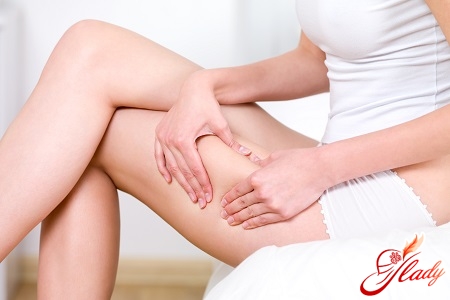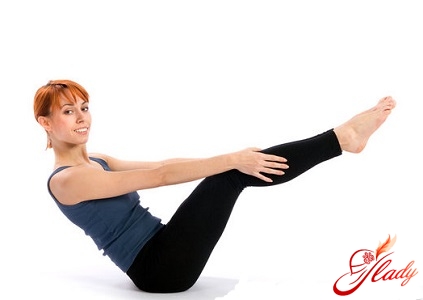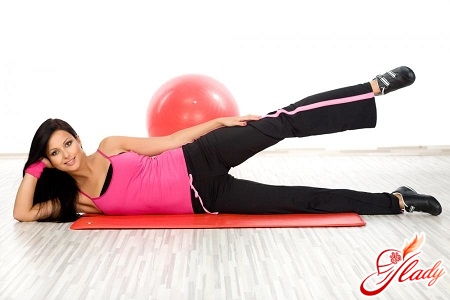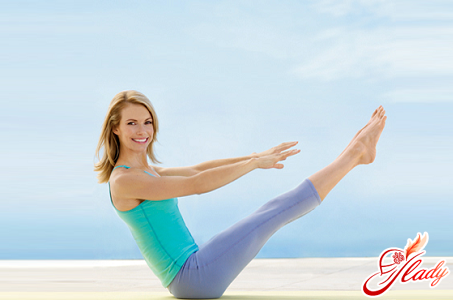 Gymnastics in the early postpartum periodreally helps the recovery process. It is important only to observe the rate of increase in load and the variety of exercises. The same exercises and boring, monotonous trainings, on the contrary, can cause a reaction opposite to what is expected. We advise you before and after childbirth to engage in phytas, then your figure will always be in perfect condition. Visiting
Gymnastics in the early postpartum periodreally helps the recovery process. It is important only to observe the rate of increase in load and the variety of exercises. The same exercises and boring, monotonous trainings, on the contrary, can cause a reaction opposite to what is expected. We advise you before and after childbirth to engage in phytas, then your figure will always be in perfect condition. Visiting you can choose for yourself that kind of training,which is suitable for you, for example, dancing and strength training, and a doctor - a nutritionist will tell you how to eat right, not at the expense of your health. If you do not have time to visit the fitness room, since you can not leave the newly born child with a nanny, grandmother or dad, you can do some exercises yourself at home. Below are described 4 small sets of exercises of restorative gymnastics. Choose the one that you can do calmly and without overstressing. Some additional instructions:
- All these exercises remain relevant throughout the postpartum period, and not only in its early phase. They can and should be done within 10-12 weeks.
- It is best to start on the first day after childbirth.
- Exercise should be done regularly, several times a day, lying on a flat surface (take a small pillow for convenience).
- Move slowly, without concentrating, smoothly. In no case is it abrupt.
- The room where you are engaged should be well ventilated. The optimum temperature is 18-20 ° C.
- It is necessary to work in a comfortable, not constraining movement clothes.
- Do not forget to go to the toilet before training.
- To train better after feeding.
- Rise from the "lying" position always by turning over the side.
- Lying most of the time is better on the abdomen, thereby supporting the involution of the uterus and reducing postpartum discharge.
- Early retirement after childbirth and walking support recovery processes. Pay attention to the good setting of the feet and especially on the "rolling" from the heel to the toe.
Restorative gymnastics
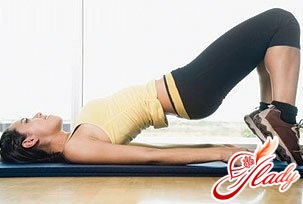
- 1st set of exercises
Exercises for the prevention of thrombosis. You can start classes on the first day after childbirth. Starting position: lying on the back, both legs are bent at the knees. Straighten your legs so that your knees with your side pieces do not break away from each other. 10 times, slowly and strongly compress your fingers ("pull in claws") and again lower. Straighten one leg. 10 times slowly and strongly pull the sock towards you, and then back. Change your foot. Do the previous exercises with both feet, without lifting them, but simply stretching out on your back. Supplement: if you had varicose veins or leg pain during pregnancy, use special elastic gaiters or stockings.
- 2nd set of exercises
When performing these exercises, you need to breathelower abdomen. You can start lessons on the first day after childbirth. Starting position: lying on the back, both legs are bent at the knees. Hands are laid on the bottom of the abdomen. Slowly inhale with a nose and then also slowly exhale with the mouth of "hahaaa". The abdomen rises during inspiration, then during exhalation lightly help him with his hands, leading his hands in the direction from the pubic bone to the navel. Do not press, but just stretch your hands on the bottom of your stomach. Then turn to the side. The head, thorax and pelvis lie on one line (you can use a small pillow or a roller under the neck), knees slightly bent. The upper arm lies on the lower part of the abdomen. And again repeat the breathing exercises with your belly, stretching out your hand as you exhale from the pubic bone to the navel (in fact, you make a movement with the pelvis forward, without bending the trunk). To increase the tension, say "pfff" or "puuch" when exhaling, while imagining that your stomach is compressed like a sponge. Then turn over on the stomach. Place a small dense pad under the lower abdomen. It is important that the pressure on the chest is minimal or nonexistent. Breathe in the lower abdomen. And again, when exhaling (for "haa", "pff" or "fluff"), again, move the pelvis forward.
- The third set of exercises
The main burden of these exercises is aimed atmuscles of the perineum and the bottom of the pelvis, so when exercising, be careful, or go to a lighter complex. One of the functions of the musculature of the pelvic floor is the support of the internal organs: the uterus, the bladder, the intestine. During labor, the "retaining" muscles of the urethra, the entrance to the vagina and the rectum, are stretched. The sphincters are weakening, and problems with controlling urination and defecation begin. If an episiotomy (cut of the perineum) was performed during labor, then it is advisable not to perform this set of exercises until the seam is healed, because the load can be very strong. In this case it is desirable to perform a set of "soft" exercises, lying on your stomach. Lying on a bed or sitting in a chair, try to alternately strain the muscles of the vagina and anus. As if "blinking". At first, you may get the impression that alternate muscle contraction is impossible, but it is not. Soon it will be possible to share the muscle tension. As soon as you manage to separate the "blinking", try using the muscles to "wave" from the anus to the pubic bone. This exercise is also an assistant in the treatment and prevention of hemorrhoids. During the exercises, you must always follow the muscles of the mouth: the tongue, the sky and the lips should be relaxed. This will help you to relax the crotch and make the breath soft. The next exercise is better to do half sitting or sitting. Try to slowly, strain the muscles of the perineum and pelvis, pass the wave from below upwards, through the pubic bone to the navel, making a slow movement of the pelvis forward. Slowly up, and then freely back. Thus it is necessary to breathe exactly, without delaying inhalations and exhalations. But please do not try to give your muscles an increased load. Exercises should be carried out easily, as if playfully.
- 4th set of exercises
In it, the control of breathing and the load on the bottom of the pelvissupplemented by training the muscles of the abdomen. Pay attention - all exercises are done on exhalation and soft tension of the pelvic muscles. Starting position: lying on its side, head, thorax and pelvis lie on one line. Knees are bent. One arm is bent at the elbow and lies under the head. The second hand rest on the bed at the level of the navel. The palm is best to squeeze into a fist. On exhalation slightly raise the pelvis, resting on the fist. Repeat several times, then do this exercise lying on the other side. Starting position: lying on the back, legs bent at the knees. Socks tucked up. During exhalation, begin to stretch your toes towards yourself, lifting both hands alternately to the right or left side. You do not need to lift your chest or lift your heels off the plane. Starting position: standing on all fours (exercise can also be performed in bed). The head, upper body and pelvis are on the same line. Knees are spaced a short distance. During an exhalation, draw in the belly and increase tension by slightly lifting the left knee and right palm. Then change the "diagonal" (raise the right knee and left palm already). Then one of the most "boring" exercises of the complex: standing on all fours, the feet lie flat, on exhalation try to straighten the knees as much as possible, without bending your back, trying to keep it as straight as possible. The bulk of the body with this exercise will press on the palm and the back of the foot. Starting position: lying on its side, knees bent. "Upper" hand lies quietly along the body, "lower" - creates an emphasis on the plane. During exhalation, tighten the abdomen and lift the torso. Then repeat the exercise on the other side. Pay attention - on the one hand, the stomach will bulge more than the other - this is a normal situation (depends on the intrauterine development of the child). On the side where the "dangling" is greater, the exercise should be performed more often. Now exercise to stabilize the muscles of the abdomen and back. The starting position is to face to the back, legs are set apart and slightly bent at the knees. Hands rest against the wall with their full palms, elbows are also pressed against the wall. During exhalation, mentally move both elbows to the navel. Then change the exercise: again mentally move your right elbow and your left knee to each other. Then left elbow and right knee. No actual movements are necessary. Back home with the baby, you can decide that you have no time to engage in physical education. But fairly simple exercises can be performed when you change diapers, before feeding the baby or combining the exercises with the game with the child. First of all, check if there is a divergence of the abdominal muscles (diastase), the muscles that go from top to bottom from the chest to the pubic bone. The connective tissue between these muscles can react to stress during pregnancy without pain and bleeding, like a zipper that opens under pressure. This discrepancy protects the muscles from excessive tension. This is normal, but it requires special attention and action to close this gap. In order to determine if there is a discrepancy between the muscles or not, lie on your back, bending your knees. Press the fingers of one hand in the abdomen, just above the navel (the fingers should be connected together and positioned horizontally). Begin slowly lift your head and shoulders off the bed or off the floor. Straight abdominal muscles will tense, allowing to detect any discrepancy. A small discrepancy (one or two fingers wide, connected together) indicates that you need to do some preliminary work before you start doing intensive exercises for the abdominal muscles. Vigorous exercises in the presence of a wide divergence will only increase the discrepancy and make them meaningless. To close the discrepancy of the abdominal muscles, start with the next exercise. When the discrepancy is narrowed to a width of one or two fingers, proceed to slide the legs and diagonal or central lifts-lowering from the supine position.
Simple exercises at home

- Exercises with lifting of the head
Lie on your back, bend your knees, handsCriss-cross the abdomen, placing your arms at the waist. Take a breath. After exhalation, start lifting your head from the bed or floor. Simultaneously, try to pull your hands straight muscles to the middle of the abdomen. Do not hesitate to count to five. Slowly lower your head. Repeat the exercise 5 times 3-4 times a day.
- Exercises to reduce the muscles of the pelvic floor
This exercise can be started immediately after birth. Gently tighten, and then relax the muscles of the perineum. This exercise can be done when you are lying, sitting or standing. You may not feel muscle contraction, but if you did this exercise before giving birth, then you know how to do it now. Start by doing two to three cuts every hour for the first few hours, then increase the load to five cuts several times a day. At first you can only hold the contraction for 2-3 seconds. In a few days - within 3-5 seconds. Gradually, muscle endurance will increase to 10, then to 20 seconds. In order to check whether there is progress in these trainings, somehow try to perform this exercise during urination - when the bladder is half freed, try to stop the flow. Do not be discouraged if at first it will not work for you. Continue to train. Check the strength and endurance of the muscles of the pelvic floor, as described above, - interrupting the flow of urine in the middle of urination.
- Pelvic Deflection
This exercise will help improve muscle tone and strengthbelly, relieve back pain, maintain a good posture. Soon after the birth, start the next exercise. Lie on your back on the bed or on the floor, bend your knees. Tighten the abdominal muscles and bend the pelvis, then take the original position. Do the exercise twice or three times. Gradually increase the number of exercises to five. In a few days, start turning the pelvis in the standing, sitting position. This exercise allows you to strengthen the muscles of the lower abdomen. Lie on your back, bending your knees, place your feet on the floor. Legs will slip better if you perform an exercise in socks or stockings. Put one or both hands under your waist. Slowly start stretching your legs, sliding your feet on the floor, until you feel that the loin breaks off from the hands or from the floor. At this point, stop sliding and pull your legs back to their original position. Repeat this exercise five times a day. Remember that the exercise is only necessary until the lumbar separation from the floor occurs. When the muscles get stronger, you can fully straighten your legs without taking your waist from the floor.
- Tilting back from the sitting position
After a week or two after delivery, beginPerform an exercise that will help strengthen the abdominal muscles. This exercise, as well as the central and diagonal ascents (described below) are safer and more effective than squats that require sharp movement and lead to an unreasonable overstrain of the waist and abdominal muscles. The "Backtracking from sitting" exercise is smoother and safer because the tension extends mainly to the pelvic portion, and you do not need to overcome the gravity at the start of the exercise. Sit down, bending your knees, pressing your feet to the floor, hands in front of you. Slowly lean back, but only until you feel weak or begin to lose control of the pose. In other words, when you begin to feel instability or weakness - you have reached your limit. Sit down and straighten up. Gradually, as you increase strength and stamina, increase the appearance. Soon you can straighten your back and touch the floor without taking your feet off the floor. Complicate the exercise. Carry the slopes with arms crossed on the chest. Later, try to do this exercise by holding the clasped hands behind the head.
- Central and Diagonal Rises
This exercise also allows you to strengthen the musclesabdominals. Central rises. Lie on your back, bending your knees, place your feet on the floor. Inhale, arch your back, pressing your lower back to the floor. During exhalation tear your head and shoulders off the floor, touching the tips of your knees with your fingers. Movements should be smooth, while the waist should be pressed to the floor. When the shoulders are raised 20 cm above the floor, stay in this position and slowly count to five. Relax and gently lie on the floor. Do not make sudden movements. First repeat this exercise five times a day. Diagonal lifts. Turning the upper part of the trunk and simultaneously lifting the head and shoulders, you can strengthen the various muscles of the abdominal press (oblique muscles). Just like with central lifts, from the very beginning, do not forget about breathing and straightening your back. As you exhale, lift the upper part of the body by turning left and touch the outside of the left knee. Hold and slowly count to five. Repeat the exercise with the rotation of the trunk on the right side. Do the exercise five times a day in each direction. Movements with central and diagonal lifts should be smooth, not gusty. As the muscles of the abdomen are strengthened, the exercises of central and diagonal uplifts can be complicated by performing them with arms crossed on the chest or with hands clasped behind the head. Gradually increase the number of repetitions from five to ten per day.
- Wide circles with hands
This exercise allows you to strengthen blood circulation inmammary glands and prevent or relieve blockage of the milk ducts. From the standing position, on your knees or sitting, pull your hands forward or sideways. Rotate both hands in wide circles, first in one direction, then in the other. Try this exercise by holding your breath. Do five to ten exercises in each direction, one at a time or several times a day or before each meal.
- Relaxation and slow breathing
Since the postpartum period is strongstress for the body, it is advisable to apply the same relaxation technique that you used during pregnancy and childbirth. On hard days, try to breathe slowly and passively for 5 minutes and passively relax and see how much it encourages and refreshes you. This technique is also useful for pain that occurs during feeding and at other times, especially in women who have more than one child.
Exercises with the child
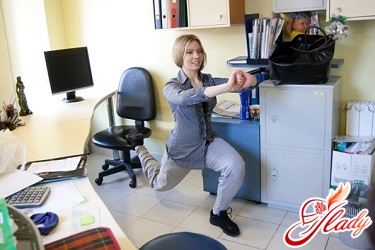 These exercises can be entertaining for both you and your child. They allow you to combine the game with the baby and increase the overall tone of the abdomen, arms, legs and buttocks.
These exercises can be entertaining for both you and your child. They allow you to combine the game with the baby and increase the overall tone of the abdomen, arms, legs and buttocks.
- Up and down (strengthening the tone of the hands)
Initial position. Lie on your back, bending your knees, place your feet on the floor. Put the child face down on his chest, holding it with his hands. Slowly and smoothly lift the child, then slowly put it on the chest. Repeat five times.
- "Twist" ("hanging on the hips")
Initial position. Sit on the floor, legs extend. Hold the child on the hips, holding his head and shoulders with his hands. "Walk" - move forward on the buttocks, wriggling during movement, then move back. Repeat four or five times.
- Swing (central rises)
Initial position. Lay down on your back, bending your hips and knees, your legs along the floor. Put the child face down on his lower leg, his gaze should be pointed over your knees. Hold it with your hands. Pressing your chin to your chest, slowly raise your head and shoulders and swing forward (it looks like a smooth central lift). Then go back to the starting position and head down to the floor. Avoid holding your breath. Repeat five times.
- Rotation (sitting)
Initial position. Sit on the floor, bending your knees, place your feet on the floor. Keep the baby against your chest or put it on your hips. Slowly flip your back, like you did in exercises with tilts back from sitting. Turn your back half a turn and go back to the starting position. Gradually increase the number of repetitions up to five times. We advise you to read:




